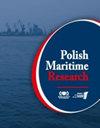Flow Field Characteristic Analysis of Cushion System of Partial Air Cushion Support Catamaran in Regular Waves
IF 2
3区 工程技术
Q2 ENGINEERING, MARINE
引用次数: 1
Abstract
Abstract In order to study the flow field characteristics of cushion system of partial air cushion support catamaran (PACSCAT) in waves, an analysis was carried out involving flexible treatment on the bow and stern air seals to simulate air seal shape under test conditions by means of computational fluid dynamics method and fluid structure interaction (FSI) method. On this basis, the pressure conditions of the air cushion chamber and the pressurized chamber at different wavelengths and different speeds are studied and compared with experimental results. The experimental results show that: for the air cushion pressure, the nonlinear characteristics of the numerical calculation results are more subtle than the experimental values, after linear transformation, the amplitudes of the experimental values are obviously greater than the calculated values after linear transformation, but the average values are not much different; At low speed of 2.0m/s, the spatial pressure distribution of the pressurized chamber and the air cushion chamber are uniformly distributed, at high speed of 3.6m/s, except for a certain pressure jump occurred in the air cushion chamber near the stern air seal, the pressure in other spaces is also evenly distributed, it proves that the pressurized chamber type of air intake can effectively meet the air cushion pressure balance.规则波中部分气垫支撑双体船缓冲系统流场特性分析
摘要为了研究部分气垫支撑双体船(PACSCAT)缓冲系统在波浪中的流场特性,采用计算流体力学方法和流固耦合(FSI)方法对船首和船尾气密封进行了柔性处理分析,模拟了试验条件下的气密封形状。在此基础上,对气垫腔和加压腔在不同波长、不同速度下的压力状况进行了研究,并与实验结果进行了比较。实验结果表明:对于气垫压力,数值计算结果的非线性特征比实验值更为微妙,线性变换后,实验值的幅值明显大于线性变换后的计算值,但平均值相差不大;低速2.0m/s时,增压室和气垫室空间压力分布均匀,高速3.6m/s时,除气垫室尾部气封附近出现一定的压力跳变外,其他空间压力分布均匀,证明增压室式进气口能有效满足气垫压力平衡。
本文章由计算机程序翻译,如有差异,请以英文原文为准。
求助全文
约1分钟内获得全文
求助全文
来源期刊

Polish Maritime Research
工程技术-工程:海洋
CiteScore
3.70
自引率
45.00%
发文量
20
审稿时长
>12 weeks
期刊介绍:
The scope of the journal covers selected issues related to all phases of product lifecycle and corresponding technologies for offshore floating and fixed structures and their components.
All researchers are invited to submit their original papers for peer review and publications related to methods of the design; production and manufacturing; maintenance and operational processes of such technical items as:
all types of vessels and their equipment,
fixed and floating offshore units and their components,
autonomous underwater vehicle (AUV) and remotely operated vehicle (ROV).
We welcome submissions from these fields in the following technical topics:
ship hydrodynamics: buoyancy and stability; ship resistance and propulsion, etc.,
structural integrity of ship and offshore unit structures: materials; welding; fatigue and fracture, etc.,
marine equipment: ship and offshore unit power plants: overboarding equipment; etc.
 求助内容:
求助内容: 应助结果提醒方式:
应助结果提醒方式:


